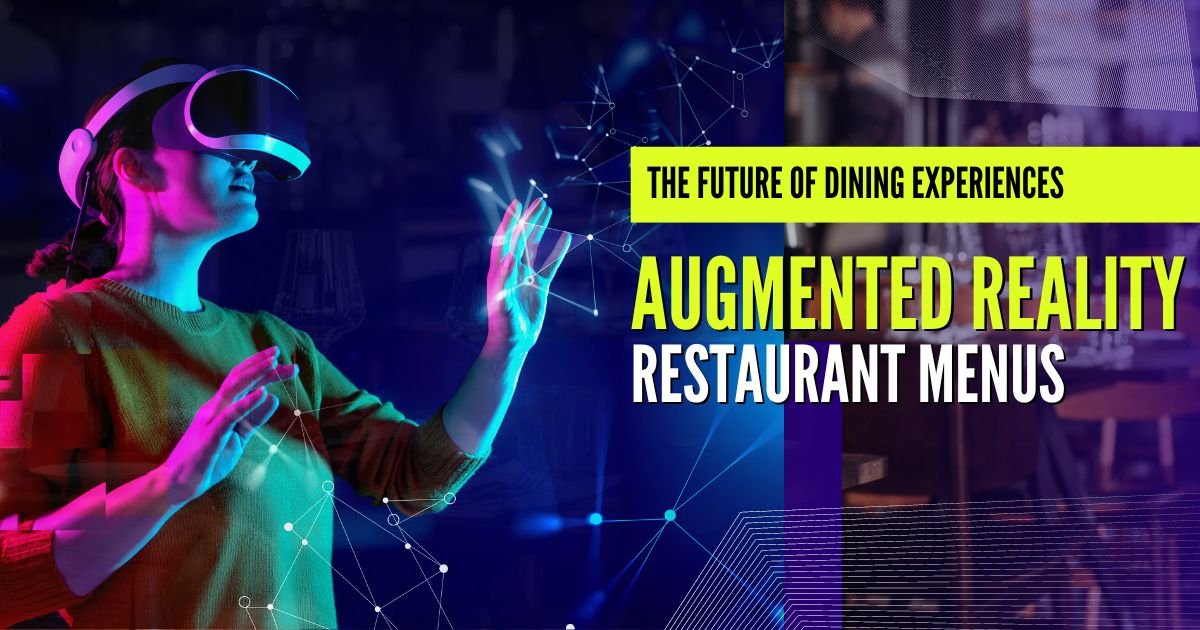The Next Evolution of Dining: Augmented Reality Menus and Enhanced Customer Experiences
Augmented reality (AR) is a technology that superimposes digital information and images onto the real world, typically via a smartphone or tablet device. In recent years, forward-thinking restaurants and bars have started experimenting with AR menus, allowing customers to view interactive 3D models of menu items, access additional information and visuals, and order directly from the AR interface.
This emerging technology has the potential to completely transform and enhance the dining experience. In this article, we will explore the current applications of AR in the restaurant industry, the benefits it provides to both customers and restaurants, the marketing potential it holds, challenges to mainstream adoption, and predictions for the future of AR menus and beyond.
Current Applications of AR in Dining
While still in its early stages, augmented reality has already been implemented in creative ways at various dining spots around the world. Customers are able to view vivid 3D visualizations of dishes directly on the table, bringing menu items to life. Additional information like ingredients, preparations, and pairings can be accessed at a tap, creating an informative and immersive dining experience.
AR also allows customers to easily customize menu items to their preferences, with an instant visualization of the personalized dish. Some restaurants use AR games to entertain customers while waiting for their food, or as an interactive way to order desserts off the menu. The technology provides opportunities for customers to learn about the history of the restaurant, get directions to the bathrooms, split bills seamlessly, and even interact with each other via multiplayer AR games.
From ordering and paying at the table to interactive experiences after the meal, augmented reality allows restaurants to engage customers in new and exhilarating ways throughout the entire dining journey.
Benefits of AR Menus for Restaurants
For restaurants and bars, incorporating AR menus provides benefits far beyond novelty and entertainment value. The technology enables restaurants to display far more menu options, details, and visuals than a physical menu allows. Space limitations on paper menus often force restaurants to condense information and limit customization. AR menus help provide an in-depth look at the full breadth of offerings available.
Visuals of menu items help restaurants showcase food in the most appetizing and artistic way. Patrons can view 3D models of menu selections from every angle, with realistic textures, ingredients, toppings, and preparation styles. This allows customers to visually understand components of a dish better. AR also reduces inaccuracies or confusion that can occur with plain text descriptions of complex dishes.
Visually appealing – restaurants can showcase dishes with 3D models, custom visual effects
While AR menu systems require an initial investment, they can improve efficiency in the long run. Ordering directly through AR allows information to be automatically sent to the kitchen staff, reducing mistakes caused by human error. Menu item orders, customizations, and notes can be sent straight to the kitchen accurately. AR data can also provide valuable insights into menu popularity and customer preferences over time, enabling data-driven menu optimizations.
Benefits of AR Menus for Customers
Get more info on dishes including visuals, ingredients, preparations, allergen info, etc.
For restaurant patrons, AR menus elevate the dining experience in multiple ways. Beyond just visually bringing dishes to life, AR allows customers to access far more information on menu items including ingredients, preparations, cooking methods, sourcing, allergen warnings, nutrition facts, and much more. Immersive visuals and information help customers imagine what a dish looks, tastes, and feels like, potentially increasing order confidence and accuracy.
Can better imagine what the dish looks like when ordering
Some AR systems allow patrons to fully customize menu items like burgers or pizzas and instantly see a visualization of the personalized dish. This is more engaging and effective than just selecting checkboxes or fillings from plain text. AR also allows customers to explore pairing suggestions, see wine labels come to life, and interact with menu items in 3D space.
The interactive and digital nature of AR makes the technology naturally engaging for millennials, Gen Zers, and tech-savvy patrons. The personalized experiences and connectivity to social media sharing provide powerful marketing for restaurants investing in AR capabilities.
Marketing Potential of AR
Augmented reality’s interactive and immersive nature offers exciting marketing potential for restaurants. The novelty of AR menus provides word of mouth marketing, with customers likely to share experiences on social media platforms like Instagram and TikTok. When integrated with smartphones, AR experiences become “insta-worthy” moments primed for digital sharing.
AR menus allow restaurants to guide customers through menu options with suggested pairings, prompts, and customization options personalized to the individual. This level of directed customer journey and storytelling is powerful for upselling, incremental revenue, and engagement. With data collected from AR interactions, restaurants gain valuable customer insights to further improve marketing and experiences.
For bars and establishments serving alcohol, AR unlocks exciting upsell opportunities through virtual drink mixing lessons, cocktail explorations, and branded games. AR mini-games can keep patrons engaged while waiting for drinks or meals, and provide subtle advertising touchpoints. The interactive technologies mesh well with modern consumers who increasingly expect participatory and digitally integrated dining and drinking experiences.
Challenges and Limitations
While interest continues to grow, augmented reality menus face challenges to mainstream adoption. Many restaurants may be hesitant to make the upfront investment in AR software, hardware, custom 3D visuals, and menu programming. The technology landscape is still developing quickly, so restaurants also risk investing in an AR system that becomes outdated within a couple of years.
Hardware challenges like mobile device battery life limitations, as well as software issues like accuracy problems or visual bugs, may hinder AR reliability in a busy real-world restaurant setting. While consumers are increasingly tech-savvy, some may still find AR menus gimmicky or overly complicated. Striking the right balance of innovation and simplicity will be critical.
Data privacy and security are also valid concerns when AR systems collect information like customer food preferences, orders, images and sharing habits. As AR technologies continue advancing, many of the existing challenges around high costs, technical limitations, software accuracy, and consumer perception will erode over time. But widespread adoption will depend on how quickly AR developers can address key pain points.
The Future of AR in Restaurants
Industry experts forecast augmented reality menus will leap from novel concept to mainstream restaurant norm within the next 3 to 5 years. The pandemic-driven boost in demand for contactless ordering, mobile payments, and digital experiences will further fuel adoption of AR technology. Enhancements in smartphone capabilities, mobile processors, cloud computing, computer vision, and 5G internet speeds will allow for more advanced and integrated AR across dining.
Beyond menus, AR promises to transform many aspects of restaurants from kitchen operations to customer experiences. Walls and tabletops could become interactive displays showcasing dishes in 3D space. Patrons may get personalized recommendations as they’re seated based on past orders, stated preferences, and items trending. AR could also enable new models of self-service and autonomy like ordering and bill splitting through mobile AR interfaces.
For high-end restaurants, AR unlocks opportunities to tell stories, convey heritage, explain techniques, and build anticipation for meals through immersive visuals and interactions. For quick service establishments, the technology offers opportunities to speed up ordering, boost accuracy, and encourage upsells through gamification and interactivity. Augmented reality is versatile enough to add value across dining experiences.
Conclusion
In many ways, AR technology perfectly complements the sensory and visual nature of the culinary world. From making menu browsing more informative and interactive to providing magical immersive moments during the meal, AR has the potential to profoundly enhance and personalize dining experiences. Though still early days, augmented reality menus are primed for dramatic growth as the technology advances and becomes more accessible.
Within the next few years, we are likely to see AR menus transition from novel innovation to expected norm across dining establishments. Much like digital menus and ordering on mobile devices, augmented reality feels like a natural next evolution in making the restaurant experience more seamless, personalized, and connected. The COVID-era has rapidly accelerated demand for these types of digital capabilities and restaurant digital marketing services.
As AR matures, consumers can expect to see experiences become more personalized and interactive based on known customer preferences and behaviors. QR code prompts at tables may one day be replaced with 3D AR cues and prompts delivered directly through patrons’ mobile devices. Just as restaurant websites evolved from static pages to interactive tools, so too will printed restaurant menus transform into immersive digital portals via augmented reality.



